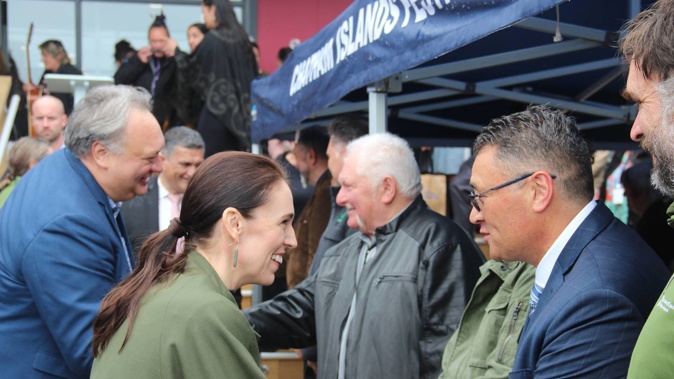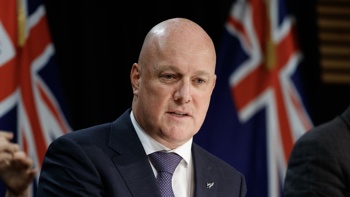
Prime Minister Jacinda Ardern has made her first visit to the Chatham Islands where locals spoke of the cost of living and housing “crisis” while sharing hopes for the future, including a much-vaunted hydropower station.
Ardern’s visit coincided with a significant development for iwi Ngāti Mutunga o Wharekura signing an agreement in principle for their Treaty of Waitangi settlement with the Crown, including important historical acknowledgements and $16 million in redress.
Ardern was also there to open a community building and museum, an occasion that drew in a decent proportion of the close to 700 inhabitants of the main island – also known as Rēkohu and Wharekauri.
There were intended to be earlier visits in Ardern’s five years in the role but Covid-19 had got in the way. This time the forecast, the skies opening up right in the middle of the pōwhiri - alluded to by many of the kaikōrero (speakers), along with the deep pockets of the Crown, both receiving appropriate chuckles.
“It feels very special, privileged to be able to be here and for people to give up their time to come,” Ardern said of the huge turnout.
“These are moments that you don’t have very often.”
But behind celebrations were similar challenges back on the mainland, with a “housing crisis” and rising cost of living, particularly for freight and diesel.
/cloudfront-ap-southeast-2.images.arcpublishing.com/nzme/XFSL7Z3WFJGBVPQK7A27SW6ZWU.jpg) PM Jacinda Ardern with Ngāti Mutunga o Wharekauri Iwi Trust CEO Gail Amaru (right) and Joseph Thomas of Ngāti Mutunga o Wharekauri, in the Chatham Islands. Photo / Michael Neilson
PM Jacinda Ardern with Ngāti Mutunga o Wharekauri Iwi Trust CEO Gail Amaru (right) and Joseph Thomas of Ngāti Mutunga o Wharekauri, in the Chatham Islands. Photo / Michael Neilson
The Chatham Islands are New Zealand’s most remotely populated area, sitting about 862km east from Christchurch and 772km from Napier.
The island group includes many small islands, but only the two main ones are inhabited: Chatham Island, also called Rēkohu or Wharekauri, and Pitt Island, also known as Rangihaute or Rangiāuria.
- 'No one can help' - shipping struggles force Chatham Islands farmers to cull stock
- Dairy stabbing: PM will visit grieving community, rejects Act’s criticism
- Economist: There are real signs global inflation pressures are starting to ease
Ngāti Mutunga o Wharekauri Iwi Trust CEO Gail Amaru in her speech spoke of the housing shortage and the work they were keen to do with the Government, including building more than 100 public homes.
She also referenced the rising costs of fuel and the pollution associated, and the need for renewable energy including hydropower.
Lead negotiator for the iwi Tom McClurg said they were hoping their Treaty settlement, hoped to be finalised next year, and stronger relationship with the Government would address those issues.
Ngāti Mutunga arrived from Taranaki in 1835, and despite their presence the islands were annexed by the Crown in 1842. The settlement allowed the iwi to start a new relationship with the Crown.
“The financial size of the settlement is not big enough to make an enormous difference, but housing is the priority for Ngāti Mutunga,” McClurg said.
“There really is a housing crisis on the Chathams. That makes it difficult to attract people here to take necessary jobs, to look after older people in a kind of warm and safe kind of environment.”
McClurg said the settlement included financial redress of $13m and $3m for cultural strengthening.
“But the most important thing is the acknowledgement that annexation occurred without proper respect to the mana, and Tino Rangatiratanga of Ngāti Mutunga o Wharekura. And I think that it is that acknowledgement, which means the most with people today.
“This is a chance to reset the whole relationship between the Government and people here.”
Moriori were the original inhabitants of the islands, arriving between the years 1000 and 1400. They developed a non-violent tradition, known as Nunuku’s law of peace.
Their population of more than 2500 people plummeted to 120 by 1862, following colonisation by both Pākehā from 1791, and Taranaki iwi Ngāti Tama and Ngāti Mutunga following their invasion in 1835, when they killed an estimated 300 Moriori - a sixth of the population - and enslaved the survivors.
In 1870, the Native Land Court awarded over 97 per cent of land to Ngāti Mutunga, based on its “conquest”, leaving Moriori with small reserves.
Moriori never accepted this “conquest” as they had upheld their law of peace, but this was ignored by the Native Land Court.
In the Moriori settlement, finalised last year, the Crown acknowledged it had failed its obligations under the Treaty of Waitangi to protect Moriori, despite their pleas for help, and that they had been left “virtually landless” since 1870, hindering their “cultural, social, and economic development”.
McLurg said there was a “challenging history” with Moriori that continued to be worked through.
“That leaves its own painful legacy. And in generations, people have found their own way to kind of deal with it.
“Most Chatham Island families are both Moriori and Ngāti Mutunga.
“So people tend to lean one way or another, and then there’s competition between the two parties.
“It’s a relief in a way to finally have all of the settlements completed or on the way to being completed. Because I think that will allow people to move out of that competitive mindset back into a cooperative frame of mind again, which is absolutely essential to life on the Chathams.”
/cloudfront-ap-southeast-2.images.arcpublishing.com/nzme/4JGSNXTNHBDXBLSWHXE5AXSUSY.jpg) Chatham Islands Mayor Monique Croon greets PM Jacinda Ardern on her first visit. Photo / Michael Neilson
Chatham Islands Mayor Monique Croon greets PM Jacinda Ardern on her first visit. Photo / Michael Neilson
On cost of living issues, Ardern said a focus was improving healthcare and particularly for elderly.
Ardern said they had supported a business case for renewable energy, with a focus on wind power, to reduce costs but also carbon emissions.
On the Ngāti Mutunga settlement and Moriori, Ardern said part of the process was preserving and sharing the unique history of the Chatham Islands as well.
“And you can see captured within these walls, some of that important and unique history that you won’t find anywhere else.”
Local MP Paul Eagle said the Government was committed to ensuring the population and economy continued to grow.
He referenced recent work on extending the airport and introducing broadband internet.
“Once the renewable energy project gets looked at the Chatham Islanders who live globally, they’ll be able to come home so that they’ll be able to live work and play here.”
Along with the museum opening was Miria Pōmare, who brought her tūpuna patu parāoa (whalebone club) to Wharekauri.
The patu parāoa was carried by Pōmare Ngātata in 1835 who led the Māori now known as Ngāti Mutunga o Wharekauri from Wellington harbour to Wharekauri.
Minister for Emergency Management Kieran McAnulty also announced $500,000 to provide water tanks and filters to 20 per cent of the households.
“Many households in the Chatham Islands lack easy access to drinking water and have been forced to get water to their homes in ways that are unaffordable, unsustainable, and at times unsafe,” McAnulty said.
“The Government is securing reliable and safe drinking water for approximately 20 per cent of households on the Islands through a 30,000-litre water tank and a water filtration system for each home.
“The Islands have been experiencing long dry periods, which has massively impacted residents who can’t connect to mains or council water supplies.
“This programme will support households identified by the local civil defence group as most at risk from increasing droughts.”
The people who became the Moriori arrived on the islands from Eastern Polynesia and New Zealand around 1400 CE. They had no contact with other people for 400 years, and developed their own distinct culture. They were hunter-gatherers with strong religious beliefs, and outlawed war and killing.
In 1791 an English ship, the Chatham, was blown off course and found the main island. Later European sealers, settlers and whalers arrived.
In 1835 two Māori groups, Ngāti Tama and Ngāti Mutunga, invaded the Chatham Islands. They had left northern Taranaki due to warfare, and were seeking somewhere else to live. Moriori greeted them, but the Māori killed more than 200 Moriori and enslaved the rest.
Last year Moriori finalised a settlement with the Crown, which included an agreed account of their history, a Crown apology, and $18m.
Take your Radio, Podcasts and Music with you









